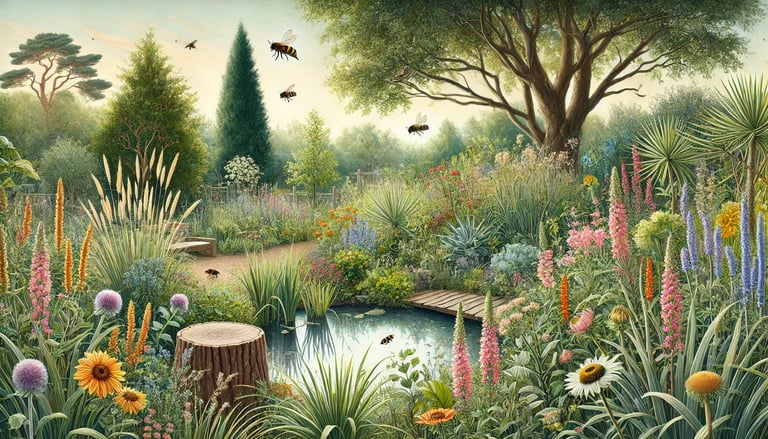The Environmental Benefits of Rewilding Your Garden
Plantastics


A Wild Garden in Your Own Backyard
What if I told you that by doing less gardening, you could do more to protect the planet? Rewilding—the act of restoring ecosystems to their natural state—isn’t just a concept for vast nature reserves. It’s a movement transforming backyards and gardens worldwide, creating havens for wildlife and revitalizing soils, all while reducing your workload.
As we face climate change, habitat loss, and a global decline in biodiversity, the practice of rewilding offers a hopeful and actionable solution—one that starts right at home. Imagine your garden not as a perfectly trimmed, pesticide-laden patch of grass, but as a flourishing microcosm of life where birds, bees, and native plants thrive together.
In this article, we’ll explore what rewilding is, its profound environmental benefits, and how you can rewild your own garden to support both the planet and your personal well-being.
What is Rewilding?
Rewilding is the process of returning land to a more natural, self-sustaining state by allowing native plants and animals to reclaim it. Unlike traditional gardening—which often involves non-native ornamental plants, fertilizers, and pesticides—rewilding focuses on:
Promoting biodiversity
Improving soil health
Letting natural processes evolve
Rewilding doesn’t mean neglecting your garden entirely. Instead, it involves making intentional choices to nurture nature—by planting native species, minimizing chemical use, and allowing natural cycles to take the lead.
Did you know? According to the WWF, home gardens using native plants can support up to 50% more pollinator species than those dominated by exotic ornamentals.
1. Boosting Biodiversity: Welcoming Wildlife Back
The current biodiversity crisis is alarming. Scientists estimate that around 1 million species are at risk of extinction, largely due to human activity. Rewilding your garden is one way to combat this trend by creating a refuge for local flora and fauna.
Native Plants: Planting native flowers, shrubs, and trees provides essential food and shelter for insects, birds, and mammals that have co-evolved with these species.
Pollinator Paradise: Bees, butterflies, and other pollinators are critical for food production and ecosystem health. A rewilded garden with diverse plants can become a thriving pollinator hub.
Birds and Insects: By allowing wild plants to grow and incorporating features like log piles or small water sources, you invite birds back into your space. These birds, in turn, help control insect populations, reducing the need for pesticides.
Example: In the UK, once-threatened hedgehog populations have started to recover in areas where residents connect gardens with small “hedgehog highways,” giving these creatures safe corridors to roam.
2. Rebuilding Healthy Soil
Healthy soil is the foundation of life on Earth, yet it’s often overlooked. Intensive agriculture and chemical treatments have degraded soils worldwide. Rewilding helps reverse this trend by:
Promoting Soil Microorganisms: Native plants and wild grasses encourage a diverse array of beneficial microbes that enhance soil structure, fertility, and carbon sequestration.
Natural Composting: Allowing leaves and other organic matter to decompose naturally returns nutrients to the soil, reducing the need for synthetic fertilizers.
Erosion Control: A garden with deep-rooted native plants stabilizes the soil, preventing erosion and improving water retention.
Soil & Climate: Some studies suggest that sustainable land management (including rewilding) could offset up to 15% of global greenhouse gas emissions by improving soil health and carbon storage.
3. Climate Change Mitigation
Rewilding can play a small but meaningful role in addressing climate change:
Carbon Capture: Plants absorb CO₂ during photosynthesis. By increasing the density and diversity of vegetation in your garden, you enhance this natural carbon sink.
Urban Heat Reduction: More vegetation helps cool local temperatures, counteracting the heat-island effect common in cities.
Water Management: A rewilded garden with permeable soil lets rainwater seep in, reducing runoff and flooding risks—vital for urban areas prone to flash floods.
Case Study: The town of Todmorden in England embraced “Incredible Edible Todmorden,” transforming public and private spaces into greener, carbon-capturing areas through community-led gardening initiatives.
4. Less Maintenance, More Harmony
Traditional lawns and ornamental gardens demand constant upkeep—mowing, watering, weeding, and applying chemicals. Rewilding flips this script, offering you more time to enjoy your garden rather than laboring in it.
No More Chemicals: Eliminating pesticides and fertilizers protects children, pets, and wildlife.
Water Savings: Native plants are adapted to local climates and often need less water, a crucial advantage in regions facing drought or water restrictions.
More Free Time: The reduced maintenance lets you relax and appreciate the natural beauty of your rewilded space—listening to birdsong or watching butterflies.
5. Enhancing Mental and Physical Well-Being
Gardens have long been places of refuge and relaxation, but a rewilded garden can amplify these benefits:
Mindful Observation: Observing butterflies flit about or listening to birds fosters a deeper connection with nature and lowers stress levels.
Physical Activity: Light gardening tasks, like planting or adding wildlife habitats, keep you active without the demands of high-maintenance lawn care.
Eco-Therapy: Studies suggest that spending time in nature reduces anxiety, improves mood, and offers “eco-therapy” benefits for mental health.
Fun Fact: Research in Scientific Reports suggests that spending at least 120 minutes a week in natural environments is linked to better overall health and well-being.
6. Supporting Sustainable Food Systems
Rewilding doesn’t mean giving up on growing food; it can actually complement it:
Pollination Boost: Attracting bees and other pollinators supports higher yields in fruit and vegetable patches.
Pest Control: Natural predators like ladybugs and birds thrive in a rewilded environment, helping keep harmful pests at bay.
Plant-Based Inspiration: Cultivating a vibrant, living garden often inspires people to adopt more environmentally friendly diets and practices.
7. How to Start Rewilding Your Garden
You don’t need a large space to make a difference. Here’s a quick guide:
Assess Your Space: Note sun exposure, soil type, and existing vegetation. Identify areas for native species or “wild zones.”
Plant Native Species: Research which plants are indigenous to your region. Local garden centers and native plant societies can help.
Create Wildlife Habitats: Consider adding a small pond, log piles, birdhouses, or insect hotels to support local fauna.
Reduce Chemicals: Gradually phase out pesticides and synthetic fertilizers. Trust nature’s own checks and balances.
Design with Aesthetics in Mind: If you’re worried about a “messy” look, add paths or defined borders to separate wild areas from walkways.
Observe and Adjust: Rewilding is an evolving process. Note what works, what doesn’t, and adapt as needed.
Tip: Keep a journal to track which native plants thrive, when pollinators appear, and how wildlife interacts with your garden.
8. Common Myths and Misconceptions
Rewilding doesn’t mean letting your garden turn into a tangle of weeds. Here are some myths debunked:
Myth: Rewilding attracts pests.Fact: A balanced ecosystem brings in natural predators that keep pests under control.
Myth: Wild gardens look untidy.Fact: With intentional design elements—like neatly edged pathways or grouping plants—rewilded gardens can be both natural and visually appealing.
Conclusion: A Small Act with a Big Impact
Rewilding your garden is more than just a trendy concept—it’s a powerful act of environmental stewardship. By letting nature guide you, you help restore ecosystems, support biodiversity, and even mitigate climate change, all while creating a peaceful haven in your own backyard.
So why wait? Let your garden go a little wild, and watch as life flourishes in ways you never imagined. Every native seed you plant and every pesticide you skip can help nurture a healthier, greener future—one garden at a time.
Take Action: Share your progress on social media, swap seeds with neighbors, or join local rewilding projects. Together, we can transform our outdoor spaces into thriving biodiversity hotspots.🌿








